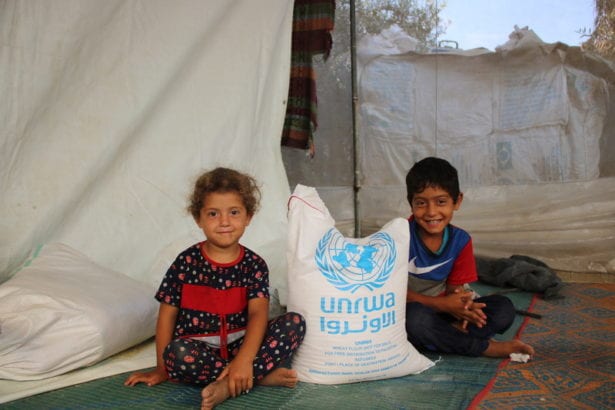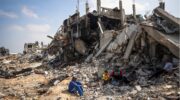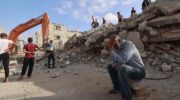The Abu Amra family receives an aid package from the UN agency for Palestine’s refugees every few months. Abdallah al-Naamy The Electronic Intifada
Israel persists in making life so miserable for Palestinians that many who can leave do just that – even if it costs them their lives. Below are four reports: about the growing malnutrition among children, Palestinians terrorized by Israeli drones, Gaza’s incendiary balloons, Israel’s recent 12 days of bombing Gaza, etc.
Electronic Intifada reports below:
Malnutrition stalks Gaza
The Electronic Intifada 27 August 2020
Muhammad Abu Amra has diabetes and cannot afford treatment.
He needs two insulin injections per day; each costs more than $7. He gets the medicine on credit.
The debt he owes to two pharmacies is continuously rising.
Muhammad and his family live in the Deir al-Balah area of central Gaza. Their home is in poor condition. It has holes in the walls and ceiling.
During the summer, the temperatures have been unbearable. His five children have sustained numerous mosquito bites.
“I feel helpless and hopeless,” Muhammad, 33, said. “My responsibilities are growing but because of my health I cannot fulfill them. And the economic situation facing my family is very bad.”
Muhammad, who is unemployed, and his wife Mansoura have little money for groceries.
The Abu Amra family receives an aid package from the UN agency for Palestine’s refugees every few months. Abdallah al-NaamyThe Electronic Intifada
“Sometimes I have to get very basic items – diapers, tissues, salt and sugar – on credit,” Mansoura said. She is banned from one supermarket until she pays a $200 bill.
“Most of the meals I make for my children rely on the cheapest vegetables I can find – like potatoes and eggplants,” Mansoura added.
“We only eat red meat or chicken once every six months. My children don’t drink milk – I am really concerned that this will harm their health in the long term.”
Every three or four months, the Abu Amra family receives an aid packet from UNRWA, the UN agency for Palestine’s refugees. It consists of flour, rice and cooking oil.
According to Mansoura, the contents of the packet are generally used up within a month.
Variety shrinks
Malnutrition is a serious problem in Gaza, a recent study by the World Food Programme stated. It found that 86 percent of children under the age of 5 living near Gaza’s boundary with Israel did not have a minimal accepted diet.
The World Food Program reported, too, that 28 percent of lactating women in Gaza have depleted levels of iron.
An earlier report by the World Food Programme and other aid groups observed that people in Gaza had responded to the harsh economic situation by reducing the variety of food they eat.
More than 68 percent of Gaza’s two million people are considered as food insecure by the United Nations. Food insecurity has been defined as not having access to or being unable to afford enough nutritious food to lead a healthy and active life.
Malnutrition has been among the consequences of the tightened blockade Israel has imposed on Gaza. Human rights activists have documented how Israel devised a plan in 2008 aimed at reducing the amount of food available in Gaza.
Aziza al-Kahlout, a spokesperson for Gaza’s social affairs ministry, said that the surrounding problems have worsened in recent months. Restrictions imposed during the COVID-19 pandemic have led to greater unemployment.
“Many people lost their sources of income – like drivers who no longer have passengers and workers from factories and other businesses that have been closed,” said al-Kahlout. “All of them and their families need urgent support in these difficult times.”
As the authorities in Gaza are under financial strain, greater support is required from international donors “to stop the humanitarian situation from deteriorating,” said al-Kahlout.
At least 50 factories have closed as a result of the pandemic and approximately 4,000 jobs have been lost in Gaza, according to the Palestinian General Federation of Trade Unions.
Poor get poorer
Mahmoud al-Lili runs a stall selling snacks in Maghazi refugee camp. Before the pandemic, he earned at least $5 per day.
The 26-year-old sometimes makes less than $1 now. Business has plummeted since the Gaza authorities imposed restrictions in response to the COVID-19 pandemic earlier this year.
“I live with my parents, sisters and my married brother in a small house,” al-Lili said. “I try my best to make some money so we have something to eat for dinner. We are a poor family but the crisis has made us even poorer.”
Samir al-Sayid is 56 and has a number of health problems, including high blood pressure. His nine-member family share a two-room home in Bureij refugee camp.
“I do not work and I cannot meet my responsibilities toward my family,” Samir said. “We rely mainly on humanitarian aid to survive.”
UNRWA’s aid packages are essential for the family.
“When we get the package, I plan carefully how to get the most out of it and try to make it last for a long time,” said Siham, Samir’s wife. “I cannot buy the food for most of the dishes my children want me to cook. Cooking for my family is a constant nightmare.”
Isra Saleh el-Namey is a journalist from Gaza.
Always on edge
By

Iyad Ghanem has heard Israel’s drones flying overhead for most of his life.
Like many other people in Gaza, he refers to these pilotless warplanes as crows. The noise they make is often called zanana, the Arabic word for buzzing.
Whenever he hears a drone, Ghanem says “the crow has come and there will be no sleep tonight.”
“I feel that someone is watching me,” the 18-year-old said. “I feel anxious when the sound gets louder, as if something terrible is going to happen.”
Ghanem can remember Israel’s November 2012 attack on Gaza “in all its detail,” he said. Drones were used heavily during that week-long offensive, when approximately 160 Palestinians were killed.
Hearing drones above brings back painful memories of that attack. “Drones cause terror to this very day,” Ghanem added.
Drones have been a prominent weapon for Israel at least since 2006, when it attacked Lebanon. They are used for reconnaissance and, on occasion, as killing machines.
Infamous
Israel has dropped bombs from drones during the three major offensives it has waged on Gaza since December 2008.
The Israeli weapons industry has tried to take advantage of those operations by marketing its drones and other weapons as “battle proven.”
Experimenting on Palestinians has proven lucrative. According to data published in 2019, Israel has become the world’s largest exporter of drones.
Israel’s drone exports were worth more than $4.6 billion over an eight-year period, according to the data, which was gathered by the consulting firm Frost & Sullivan.
Drones became infamous for “roof knocking” during a major Israeli attack on Gaza in 2014. That was a euphemism for how bombs were dropped from drones on civilian buildings as a “warning” of a more powerful blast.
Israel sought to imply that “roof knocking” was a humane gesture to protect civilians by warning them in advance that their homes would be destroyed. In practice, civilians were often not given enough time to evacuate before the deadlier explosion occurred, as a United Nations fact-finding mission confirmed.
Drones were used during some particularly horrific episodes of the attack six years ago.
Adham Shakhsa is a 40-year-old living in al-Shujaiyeh, a neighborhood of Gaza City where Israel carried out a massacre during the 2014 offensive.
“Three days before the massacre, there were drones hovering in the sky above al-Shujaiyeh,” he said. “We could see them with the naked eye and they were very loud. We have become used to this situation during Israel’s wars. I realized that Israel used drone technology to observe people in the neighborhood before the massacre.”
Another al-Shujaiyeh resident, Anas al-Madhoun, points out that Gaza’s children know more about military belligerence than their peers in most other countries. At an early age, they learn to distinguish between the sounds of drones and those made by other weapons in Israel’s arsenal, notably US-made Apache helicopters and F-16 jets.
“It is incredible to hear Israel defending itself before the international media,” al-Madhoun said. “It is incredible to hear Israel claiming that it doesn’t besiege Gaza, that it is just protecting itself.”
Constant surveillance
Drones can be heard frequently over Gaza’s skies in supposedly more peaceful times – when Gaza is subject to a blockade rather than a blitz. Drones serve as a reminder that Palestinians are under constant surveillance.
Mahmoud Siyam, a psychiatrist, argues that Israel is, in effect, torturing Gaza’s people by monitoring them with drones.
Humans require calmness and relaxation. Deprived of these essential needs, their mental health can be damaged.
Hearing drones “puts psychological pressure on everyone,” said Siyam. “The noise of drones makes people irritable. People may feel extreme anxiety and lose their ability to concentrate.”
Israel began subjecting Palestinians to drone flights after withdrawing settlers from Gaza in 2005. The withdrawal meant that Israel’s occupation was moved to the periphery and that Israel’s brutality against Gaza’s people continued and, in many ways, intensified.
Iman al-Mansi lives on the ninth floor of a tower block in the Tel al-Hawa area of Gaza City. Drones prevent her and her family from leading a normal life.
“The sound of drones is very loud,” she said. “We cannot sleep when we hear them. We cannot watch television. When there is a drone near us, it always interferes with satellite reception. We have been living like this since 2006.”
Ahmad al-Husari, who lives in al-Zaytoun, also a Gaza City neighborhood, often gets a headache from the sound of drones.
“Sometimes the drones are so noisy they are like a car’s engine getting louder as the driver gets faster,” he said. “The drones make my children wake up and then they cannot go back to sleep. Sometimes I hate evenings because of all this noise.”
Amjad Ayman Yaghi is a journalist based in Gaza.
Better to launch balloons than die in silence
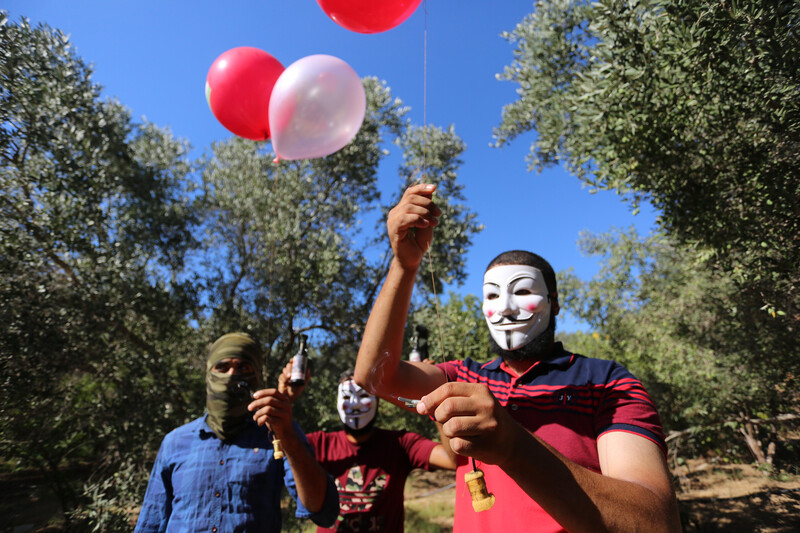
In recent weeks, the tension between Palestinians in Gaza and Israel’s forces of occupation has increased. Israel has used the launching of incendiary balloons by Palestinian youths as a pretext to bomb Gaza once again.
The release of the balloons is a gesture of protest against how the Israeli occupation has procrastinated in abiding by its previous agreements with the Palestinian resistance. Under those agreements, Israel had committed to easing the siege on Gaza.
This procrastination has caused the continued deterioration of Gaza’s health and public services and its economy. Meanwhile, the Israeli government continues to control the movement of goods and people in and out of Gaza.
The Israeli military has responded to the incendiary balloons by carrying out dozens of raids on sites used by Palestinian resistance fighters with US-made F-16 jets. The Israeli naval forces, which besiege Gaza from the sea, have prevented fishers from doing their work and fired at their boats.
The Israeli government has also closed the only crossing through which commercial goods enter Gaza. This closure led to the shutting down of the only power plant in the territory, which, in turn, means households in Gaza receive only four hours of electricity per day.
Israeli Prime Minister Benjamin Netanyahu has stated frankly that Israel would respond to the incendiary balloons in the same way as it responds to rockets fired from Gaza. Israel, it seems, wishes to keep on responding with deadly force to largely symbolic acts of resistance that make use of very basic materials.
Israel has put this statement into practice by dropping highly destructive missiles from F-16s onto densely populated Gaza for 13 consecutive nights.
The incendiary balloons bear no resemblance to Israel’s sophisticated and modern weapons. Youths have simply attached burning wicks to balloons and released them toward Israel.
The balloons have been carried into Israel by the wind. They have caused some fires on farm land and, as a result, incurred a small amount of damage to Israel’s economy.
Yet nobody has been killed or injured by them.
Compelled to act
Israel and pro-Israeli media exaggerate the effects of this form of resistance while completely ignoring the reasons motivating it.
If one wishes to understand why incendiary balloons have been launched from Gaza, it is crucial to go back to the circumstances under which Palestinian youths feel compelled to act.
I have been asked repeatedly by many Western journalists if the youth who launch incendiary balloons are contradicting the principles of the Great March of Return, unarmed protests which began in 2018.
I have replied by asking the journalists to imagine a person locked in a room without access to food or medicine while they are dying slowly and silently. The person decides to bang on the door of the room with all their strength and anger and shouts for their freedom and their need to escape from death.
Then their jailer comes from outside to give a moral sermon and tell people: Look at this prisoner’s barbarism. They are not behaving properly because they are not knocking on the door calmly and not presenting their demands to us in a respectful way.
It is unfair to blame the victim, to be preoccupied with assessing their behavior. By neglecting to address the root of the problem, we are distracted from the real criminal, the one who placed a prisoner in those life-threatening and inhuman conditions.
Whatever a prisoner who feels death approaching them does, their behavior will be in harmony with the principles of freedom and justice, even if they break the door of the prison cell.
This analogy captures Israel’s behavior toward Palestinians in Gaza. Israel has exaggerated the significance of the simple incendiary balloons launched by groups of Palestinian youths.
Israel has tried to portray these balloons as akin to a military threat. By doing so, it has tried to devise new “rules.”
Under those “rules,” Israel thinks it may respond to crude balloons with missiles launched from F-16 warplanes.
Banging on the tank’s walls
Israel says nothing about the political and economic environment in which the young people who release those balloons are growing up.
These young people are victims of Israeli aggression many times over.
Their problems began before they were born. In 1948, their families were expelled from their villages by Zionist forces.
Two-thirds of Gaza’s population are refugees hailing from towns and villages in what is now called Israel.
Many young Palestinians can see their families’ original villages beyond the fence separating Gaza and Israel. But they cannot reach them.
That offers some explanation as to the motives of people releasing balloons. The balloons are crossing the boundary and reaching towns and villages that have been stolen from Palestinians.
They are being flown as a protest against the theft of our homeland.
After the expulsions of 1948, Israel committed countless other crimes. Those include occupation, massacres, the mass detention and torture of Palestinians.
They have included, too, a siege that has deprived Palestinians in Gaza of basic rights and necessities. The siege has undermined our economy, destroyed the labor market and shattered the dreams of Palestinian youth for a decent life.
Gaza’s youth banged against the prison walls during the Great March of Return. Israel responded by firing live bullets against them, causing death and permanent disabilities.
These youths, crushed by the Israeli occupation and deprived of their fundamental rights, still feel the urge to scream at their jailers. They want to make noise so that they do not die in silence.
In his novel Men in the Sun, Ghassan Kanafani tells a story of three Palestinians undertaking a perilous journey hidden in a water tank. After the men are found dead by their driver, Kanafani asks why they didn’t bang on the water tank wall.
Banging on the walls of a tank is better than suffocating.
Launching handmade incendiary balloons from the besieged Gaza Strip is like banging on the walls of a water tank and refusing to die in silence.
Ahmed Abu Artema is a writer who lives in Gaza and a researcher at the Center for Political and Development Studies. He is one of the organizers of the Great March of Return.
Israel’s crimes must be met with arms embargo
By Maureen Clare Murphy Rights and Accountability, reposted from The Electronic Intifada 25 August 2020
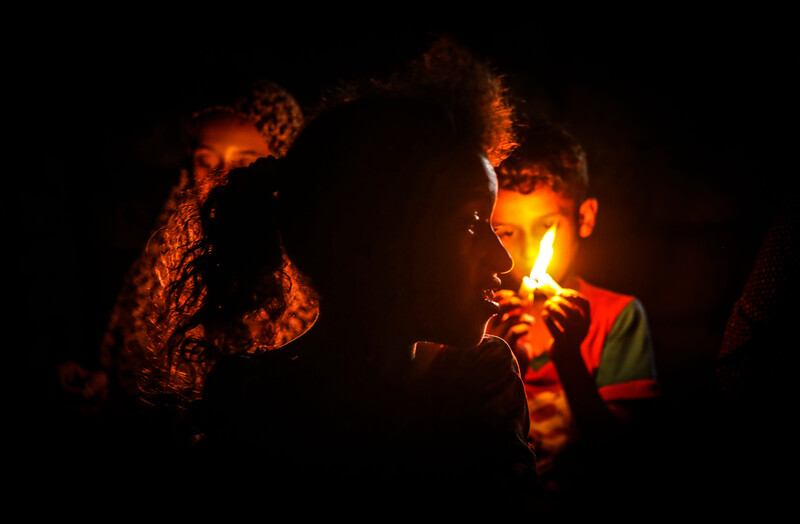
Israel’s bombing of the besieged Gaza Strip must be met with an “urgent and comprehensive military embargo,” the Palestinian Boycott, Divestment and Sanctions National Committee stated on Sunday.
Israel has bombed Gaza every night for the past 12 days in response, or so it claims, to incendiary balloons flown from the territory. Those balloons have caused fires on agricultural land in southern Israel.
Two-thirds of Gaza’s population of 2.1 million are refugees, some of them from the lands just on the other side of the Gaza boundary fence. Israel denies them their right to return, enshrined in international law, while encouraging Jews worldwide to emigrate to Israel.
Gaza has been under a devastating blockade enforced by Israel and Egypt for the past 13 years.
Israel has faced and has paid little consequence aside from Palestinian resistance in the form of mass protests, rocket fire and incendiary balloons.
Palestinians living in the Gaza Strip are deprived of basic human rights under the siege.
Coupled with repeated Israeli military offensives, the siege has eroded the functioning of the health system while Gaza’s authorities cope with the first confirmed cases of COVID-19 outside of quarantine centers in the territory.
Health authorities on Monday confirmed four cases in the same family in Maghazi refugee camp in Gaza’s central region.
Authorities declared an immediate 48-hour lockdown in hopes of thwarting community transmission.
The infection was brought to Gaza by a member of the affected family who had recently visited a hospital in occupied East Jerusalem, the health ministry said.
The health ministry said it would hold Israel responsible for any escalated military aggression during the current state of emergency in Gaza.
Israel’s siege has also sharply increased poverty and aid dependency in the territory has grown ten-fold.
The bleak environment in Gaza has driven many of its young people to despair.
Nearly half of Gaza’s population are children under the age of 15. Most households are moderately to severely food insecure with unemployment rates in the territory among the highest in the world.
Gaza’s children have already lived through multiple Israeli military campaigns.
Escalation looms
A Qatari envoy is reportedly planning to visit Gaza this week to prevent another escalated confrontation.
A senior Hamas official told the Tel Aviv daily Haaretz that the incendiary balloons won’t stop unless Israel significantly eases the siege.
“I belong to the ranks of senior academics in Gaza and this weekend I couldn’t bring food for my children, so you can understand what happens to the weaker population,” the unnamed official said.
Gaza’s sole power station stopped generating electricity last week after Israel halted fuel supplies in an act of collective punishment over the incendiary balloons launched from the Strip.
Collective punishment is a violation of the Fourth Geneva Convention – a war crime.
Currently, households in Gaza have three to four hours of electricity per day on average.
Impunity reigns
The Palestinian Boycott, Divestment and Sanctions National Committee noted in its statement on Sunday that the “new wave of Israeli bombings of Gaza coincides with the sixth anniversary of Israel’s 2014 massacre.”
More than 2,250 Palestinians, including 550 children, were killed during that 51-day offensive.
An independent commission of inquiry formed by the United Nations investigated Israel’s conduct in Gaza in 2014 and stated its concern that “impunity prevails across the board” when it comes to rights violations committed by Israeli forces.
The commission added that the “persistent lack of implementation of recommendations” by previous investigators and various UN bodies towards accountability “lies at the heart of the systematic recurrence of violations.”
Instead, Israel has only been rewarded with normalized relations with “despotic Arab regimes,” as the boycott national committee put it. Those regimes include the UAE, which recently formalized relations with Israel.
That development was applauded by UN Secretary-General António Guterres:
The UAE-Israel agreement was also welcomed by Nickolay Mladenov, the secretary-general’s Middle East peace envoy:
With those plaudits came statements of hope for re-engagement in “meaningful negotiations” towards a two-state solution.
Though without having to pay any price, it is hard to see why Israel would see any reason to stop proceeding as usual.
That means meeting any Palestinian resistance to decades of oppression with lethal force.
It means continuing with de facto annexation of West Bank land through confiscation and settlement construction.
It means making life so miserable for Palestinians that many who can leave do just that – even if it costs them their lives.
And it means profiting from the situation by marketing weaponry as “field-tested” on Palestinians to the very countries that instead of sanctioning Israel, purchase its war and surveillance technologies.
As the Palestinian Boycott, Divestment and Sanctions National Committee said, the complicity of Western government such as the US, UK and the European Union allows Israel’s “crimes against a captive civilian population” in Gaza to proceed with impunity.
The group is calling for popular pressure on governments to impose military embargoes on Israel. It is also encouraging intensified academic and cultural boycott campaigns, as well as campaigns targeting corporations that enable and profit from Israel’s crimes.
For the long-suffering Palestinians in Gaza, a return to the status quo – as UN and Qatari officials seem keen to secure – is not an option.
Maureen Clare Murphy is an associate editor of The Electronic Intifada and lives in Chicago.
RELATED:
Chronic malnutrition in Gaza blamed on Israel
Study says attacks on infrastructure in Gaza and West Bank exact human cost
Gaza incendiary balloons are ‘distress signals’ against Israel’s cruel blockade
Understanding the Crisis in Gaza
Israeli airstrikes vs Palestinian rockets: Facts & Stats on air attacks

